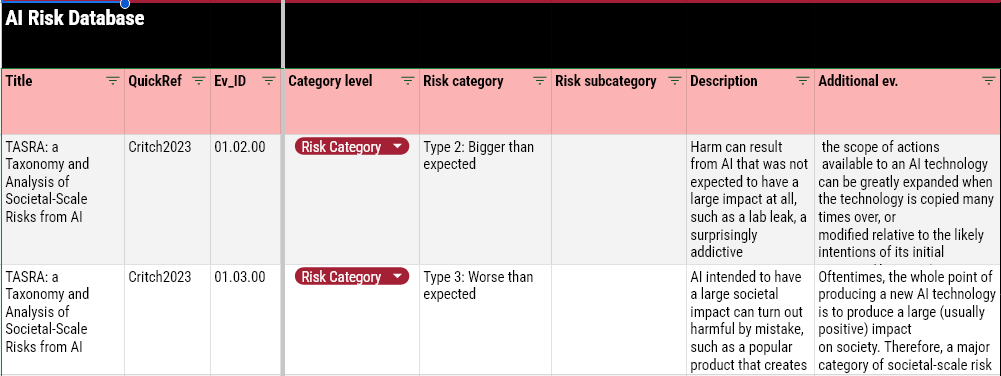Understanding the risks in any organisation or project takes time and usually involves one or more risk workshops, more often than not starting with a blank sheet of paper. Massachusetts Institute of Technology (MIT) have provided us with a short cut to identify risks associated with artificial intelligence using a new resource, the AI Risk Repository – save time and improve the breadth and depth of risks.
What is it?
The AI Risk Repository is a database that compiles and categorises the various risks posed by AI. Developed through reviews of existing research and expert consultations, this repository includes 777 identified risks from 43 existing sources, organised into 2 primary taxonomies (snippet below). The first is the Causal Taxonomy, which classifies risks based on their causes, such as human error or AI system failures. The second is the Domain Taxonomy, which groups risks into seven key areas, including privacy, misinformation, and AI system safety.
This resource is designed to be a living database, it can be continuously updated as new risks emerge and the understanding of AI evolves. It’s accessible, modifiable, and intended to serve as a common frame of reference for anyone involved in AI—from policymakers to business leaders.
What does it mean from a business perspective?
For businesses, the AI Risk Repository offers a crucial tool for managing the uncertainties that come with AI deployment, and it saves you time. As AI becomes more integrated into business operations, understanding potential risks is essential for avoiding costly mistakes and helping to ensure compliance.
Understanding these risks allows organisations to better prepare for and mitigate potential challenges, safeguarding their reputation and operational integrity.
What do I do with it?
- Get the database into the hands of the teams that identify and manage risk. This database should be in the hands of the groups that manage enterprise risk (your ERM team), AI projects (start with your PMO), AI operations teams and compliance departments. Start by exploring the database to become familiar with the risks relevant to your industry. Identify the domains that pose the greatest potential threats to your business, such as privacy and security or misinformation.
- Integrate these insights into your risk management frameworks at the enterprise, project and operations levels. Use the repository to kick start your risk assessment and management plans – don’t start with a blank sheet of paper.
- Monitor the database. Finally, keep an eye on updates to the database. As AI technology and associated risks evolve, staying informed will be key to protecting your organisation from unforeseen challenges.
It’s inevitable that you’ll discover risks unique to your specific environment. However, instead of starting from scratch with a blank sheet of paper—or more commonly, a blank whiteboard and a pile of sticky notes—you can kick start the process by using an existing database like this one.

Additional Reading
The AI Risk Repository – Document Reprint
The AI Risk Repository Website
#AI #RiskManagement #ArtificialIntelligence #BusinessStrategy #Innovation #TechLeadership #AICompliance #DigitalTransformation